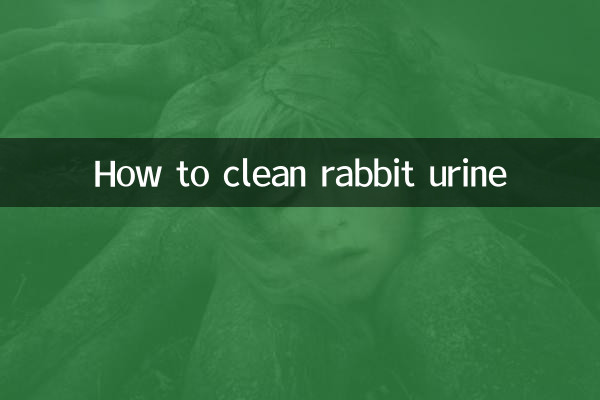How to clean rabbit urine: Popular topics and practical guides on the entire network in the past 10 days
Rabbits are becoming more and more popular as pets, but how to clean rabbit urine has caused headaches for many novice owners. This article will combine popular topics and hot content on the entire network for the past 10 days to provide you with a structured cleaning guide to help you easily solve this problem.
1. Check out the popular topics on raising rabbits in the past 10 days on the entire network

| Ranking | Hot Topics | Popularity index | Main discussion points |
|---|---|---|---|
| 1 | How to remove rabbit urine stains | 9.2 | Recommended natural detergents, taste removal tips |
| 2 | Rabbit toilet training | 8.7 | Training cycle, effective reward method |
| 3 | The relationship between rabbit health and urine | 8.5 | Urine color determines health and abnormal symptoms |
| 4 | Selection of environmentally friendly rabbit cage cushion material | 7.9 | Water absorption comparison, cost-effectiveness analysis |
2. Detailed steps for cleaning rabbit urine
1.Daily cleaning: It is recommended to clean the urine in the rabbit cage at least once a day. After cleaning the solid waste with a special shovel, suck the urine dry with a highly absorbent disposable rag or old newspaper.
2.Deep cleaning: Thorough cleaning once a week. After transferring the rabbit to a safe area, use the following recommended detergents:
| Cleaner type | advantage | Things to note |
|---|---|---|
| White vinegar solution (1:1) | Natural and harmless, good deodorization effect | It needs to be rinsed thoroughly to avoid residue |
| Baking soda paste | Strong stain removal, environmentally friendly and safe | Leave it for 10 minutes before wiping |
| Pet-specific disinfectant | Thorough sterilization and easy to use | Choose fragrance-free products |
3.Deodorization treatment: Rabbit's urine has a strong smell. After cleaning, you can place activated carbon bags or dry tea bags in the cage to continuously absorb odors.
3. Effective measures to prevent rabbits from urinating randomly
According to the hot discussions in the past 10 days, the most highly regarded prevention methods include:
1.Fixed toilet training: Set up a special toilet area in the cage and lay a water-absorbing cushion. Every time a rabbit is found urinating in other places, immediately move the excrement to the toilet area to help the rabbit build memory.
2.Dietary control: Excessive drinking of water will lead to frequent urination, and the daily water consumption is appropriately controlled (adult rabbits weigh about 100-150ml per kilogram).
3.Environment optimization: Keep the cage dry and comfortable, and change the mat material regularly. The latest popular discussion shows that the following mat combinations are the most popular:
| Bottom cushion | Upper cushion material | Average usage time | Water absorption score |
|---|---|---|---|
| Pet urine pad | Wooden grains | 3-4 days | 9.0 |
| Recycled paper cotton | hay | 2-3 days | 8.5 |
| Corn Cob Lumber | none | 5-7 days | 8.2 |
4. Health warning: Check the rabbit's physical condition from urine
Recently, many pet doctors have reminded on social platforms that the color and status of rabbit urine can reflect health status:
1.Normal urine: Light yellow to amber color, with a slight turbidity (because of calcium content).
2.Exception:
| Urine characteristics | Possible Causes | Coping suggestions |
|---|---|---|
| Dark orange/red | Food pigment or hematuria | Stop feeding of colored vegetables, seek medical treatment if there is no improvement |
| More white precipitation | Calcium excess | Reduce high-calcium foods and increase drinking water |
| Pungent ammonia odor | Dehydration or infection | Check drinking water and seek medical treatment if necessary |
5. The latest experience sharing of rabbit raising experts
Combining the recent popular posts on multiple pet forums, the following tips have received high likes:
1. Lay a waterproof pad on the bottom of the cage for overall cleaning.
2. Use enzyme cleanser to treat stubborn urine stains and decompose them more thoroughly.
3. Train rabbits to use toilet bowls with guardrails to reduce urine splashing.
4. Increase the cleaning frequency during high temperatures in summer to prevent bacteria from growing.
Through the above systematic cleaning methods and preventive measures, you can not only keep the rabbit cage clean and hygienic, but also promptly detect rabbit health problems. Remember, patience and regularity are the key to raising a good rabbit!

check the details

check the details